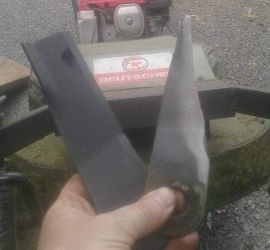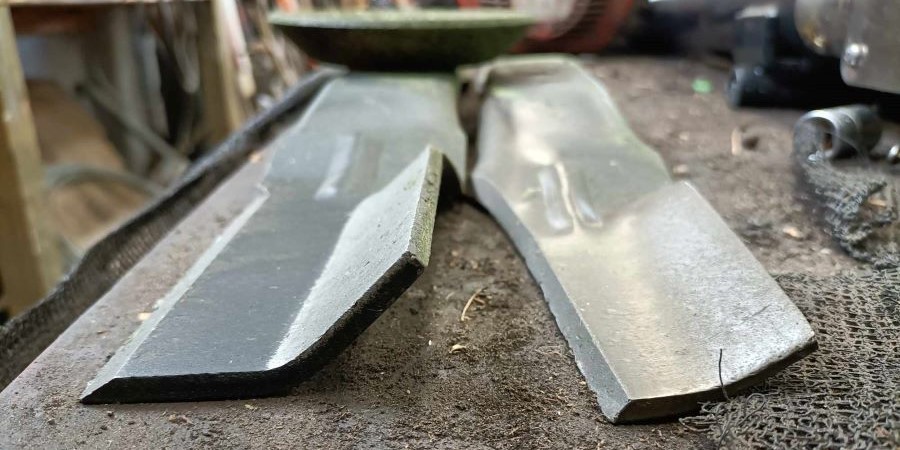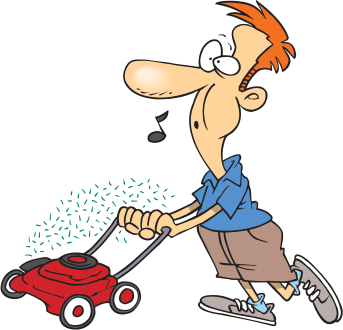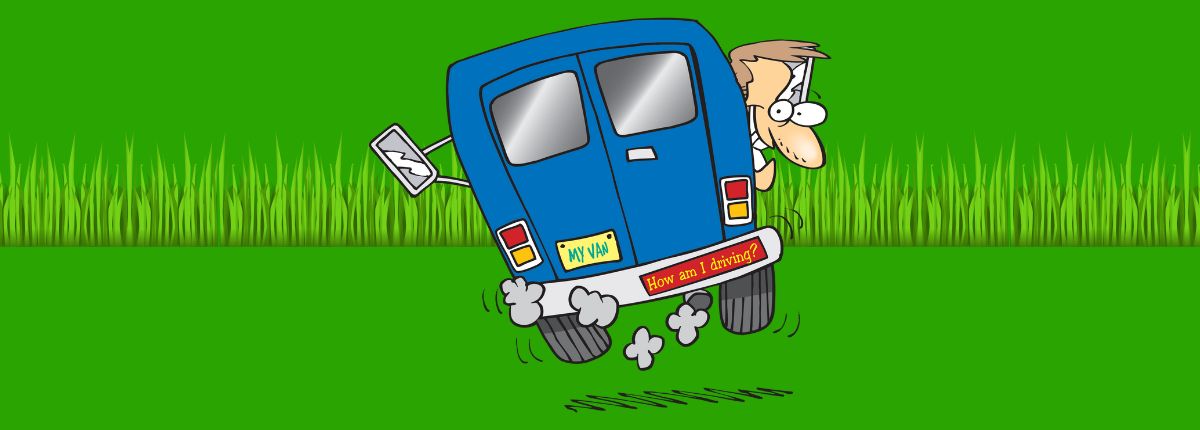How often should you change your lawn mower blades?
Table of Contents
So how important is a sharp blade and how do you know when a blade should be replaced? In my thirty years of cutting lawns, I have seen some blades that have been sharpened within an inch of their lives and they still work. How well do they work? That is the real question.

This article will give you an idea of the stages of life for a lawn mowing blade. It is not just my own opinion. I reached out to my Facebook group of over 1500 members who work in the lawn care industry and I asked them too. Some of the responses surprised me.
It is also a guide to how often they need to be replaced and how the blade’s workload can dictate when it’s done.
Signs that your lawn mower blades need replacing
These are the tell-tale signs that you may need to replace your mower blades.
Dull and uneven cuts
Your blade should be cleanly cutting the grass not tearing it. If the grass looks shabby or untidy after cutting it may be to to change the blade. Having said that sometimes if you sharpen your blades this issue will disappear as dull mower blades shred grass. I would try sharpening first and if that doesn’t help them a replacement is in order.
Another way this could show is if it is cutting deeper on one side of the mower. This could be either the blade or a worn axle. Try pushing the front wheel of the mower on the deep-cut side. If there is play, it will be either a bearing or the axle. If not check the blade.

Excessive vibration
If you are getting a vibration coming through the mower then that is a bad sign. Usually, a vibration is because the blade is damaged. This is more than likely due to hitting a foreign object. An easy way to check if your blade is bent is to
- Remove the spark plug cap.
- Lift the mower upwards with the spark plug facing the sky.
- Make with a felt tip on the inside of the deck when the end of the blade is sitting.
- Now turn the blade 180 degrees and check the other side of the blade.
- If it sits on the line, the blade is not bent.
- If it’s off the line, you need to change the blade.
I’m fortunate because I always have a new blade in stock. If I suspect a blade is bent I just check it against the new blade.
Check for Visible damage or wear
Visually check the blade. If you see small nicks they can can normally be sharpened out. If you have larger nicks it could be time to replace the blade.
Reduced mulching or bagging effectiveness
One of the easiest signs to spot when you are cutting a lawn is that the mower is throwing less grass into the bag. The more worn a blade gets the less grass it picks up. You may also notice lines on grass clippings in irregular patterns around your lawn.
Excessive Fuel Consumption:
If you notice that you are starting to go through a lot more fuel than usual. That could also be a sign that the blades need sharpening or replacing.
Check the fin
This is something that I have not seen anyone else write about but I know a lot of contacters who use this method, including myself.

What is the fin?
The blade fin is the wing on the end of the blade that gives it the lift. When the blade is new, the fin is high and you get great life. This means you can catch or mulch and it comes out great. As the blade gets older the fin starts wearing out. An old worn fin hardly gets any lift at all. Therefore your mulch cut is lumpy and your mower doesn’t catch well anymore.
I can sharpen a blade to the bone and still get a great cut, however, if the fin wears out it’s time to replace the blade
Lawnmowing101 Membership

Build a six-figure lawn care business
Lawn Care Software

Get Your Lawn Care Business Running Smoothly
Easier for you and your customers. Jobber helps you quote, schedule, invoice, and get paid—all in one place.
Frequency of blade replacement
Unfortunately, there is no set amount of time that you can set to replace your blade. It is dependent on a lot of different external factors.
Factors that impact blade wear
Frequency:
- It goes without saying that the more you cut your lawn the faster the blades will wear out.
Lawn Size:
- It’s not so much about the size of the lawn. It is about how long your lawnmower blade works. It is of course going to be working a lot longer to mow a large section than it would a tiny section.
Blade Type:
Some blades last longer than others. This could be due to a few factors.
- If the blade is made out of high or low-quality steel
- The design of the blade
- The coating on the blade.
Grass Type:
Finely we have grass types. Some grasses are hard on blades such as
- Bermuda Grass (Cynodon dactylon):
- St. Augustine Grass (Stenotaphrum secundatum):
- Zoysia Grass (Zoysia spp.):
- Centipede Grass (Eremochloa ophiuroids):
- Buffalo Grass (Buchloe dactyloides):
Different recommendations for residential and commercial use
The workload sets general recommendations for blade replacement frequency. This means that someone using a lawnmower commercially would expect to replace blades more often than someone cutting a domestic lawn.
Domestic lawn mowing
The best generic answer I can give you is that a good time to replace the blade on a domestic mower is at the beginning of the mowing season.
Commercial lawn mowing
With my lawn care business, I have a different system. I keep a spare set of blades for all my mowers. Once a month I service all the mowers. This includes pressure washing the mowers, and pulling off the blades. I then check the blades by putting the old and a new blade together and comparing them. If the blades have large chips or dents, I replace them. If they are fine, I sharpen them.

Benefits of regular blade maintenance
These are some of the benefits you could expect with a well-maintained blade.
Healthy Lawn Growth:
If your blade is sharp it gives you a much cleaner cut which promotes a healthy lawn. The result looks better is more uniform and looks well groomed.
Less diseases – If the cutting edge of your blade is dull it tears the grass blades as it cuts and torn grass is susceptible to diseases. Damaged grass can encourage pathogens, increasing the risk of disease transmission.
Less thatching – Thatch is a layer of dead grass and roots that sit on top of the soil. Dull blades add to this layer and make the problem worse.
Extended Lawn Mower Lifespan:
Less stress on the mower engine: If your blades are sharp then your engine is working less to cut the lawn. This improves fuel efficiency and overall performance.
Time and Energy Savings: You will find it easier and quicker to mow the lawn. The lawn mower will be running for less time and your machine will last longer.
Listen to audiobooks while you work.

With a sixty-day free trial
Discover millions of ebooks, audiobooks, and so much more for just $9.99/month.
How to extend the life of your lawn mower blades
Here are some ways that you can prolong the life of your blades.
Mow a Dry Lawn: Try to mow that lawn on a dry day after the dew has dried off. Wet grass puts more strain on the mower. When Is the Best Time to Mow a Lawn? Optimal Times Revealed
Keep the Lawn Tidy: Remove anything that can damage the blades. Objects such as rocks, roots, or large branches can cause nicks and damage to the blade.
Mow the lawn high and often: Follow the one-third rule and never take more than a third off the lawn. Cutting a lawn low stresses the grass and wears out the blades faster.
Sharpen the Blades Regularly:
You have probably figured this out by now, sharp blades are are must. We shape our blades once a month but for a domestic lawn, you could sharpen them a few times in the growing season.
New blades do last longer before they need sharpening. Commercially they will last for a few months, domestically possibility up to the end of the season. For more information on how to sharpen blades go here Do New Lawn Mower Blades Need Sharpening?

Conclusion – How often should you change your lawn mower blades?
In this guide, about maintaining lawn mower blades we explored signs that indicate when replacement is needed. These signs include uneven cuts, excessive vibration, visible damage or wear reduced effectiveness in mulching or bagging, and increased fuel consumption.
We also discussed the importance of an indicator called the “fin” in determining blade efficiency. Factors such as mowing frequency, lawn size, blade type, and grass type were examined to understand how they affect blade wear. We provided recommendations for both commercial use with a focus on proactive blade replacement to ensure optimal performance.
We then highlighted the benefits of blade maintenance for promoting lawn growth while preventing diseases and thatch buildup. It also discussed how proper maintenance can extend the lifespan of the lawn mower. Practical tips were provided to help extend the life of blades including mowing a lawn keeping the lawn tidy following the one-third rule (not cutting off than one-third of grass height) and regularly sharpening blades. Lastly, we addressed how often blades should be replaced with a nuanced approach for both commercial users.
Blade maintenance is a factor
Blade maintenance emerged as a factor, in achieving a well-groomed and healthy lawn. A sharp blade not only ensures cuts but also promotes even growth while reducing the risk of diseases and thatch buildup.
Furthermore, it’s important to note that keeping the mower blades sharp has advantages. Firstly it reduces strain, on the mower engine, which leads to fuel efficiency and a longer lifespan for the equipment.
The article emphasizes the significance of maintenance to fully enjoy these benefits highlighting how a maintained blade greatly contributes to both the health of your lawn and the overall effectiveness of your mower.

Consider blade replacement when necessary;
The guide stresses the importance of being attentive to signs that indicate a need for blade replacement. These signs may include cuts, excessive vibrations, visible damage, reduced performance in mulching or bagging, and increased fuel consumption.
The article offers steps on how to assess the condition of your blade, including a method involving an examination of its fin. It advises readers that taking an approach, towards replacing blades based on workload and usage patterns can ensure performance.
Ultimately I encourage you to prolong your lawnmower’s lifespan by replacing blades as needed.
Get tips & tricks on how to grow a profitable lawn care business delivered to you inbox every week.






Leave a Reply